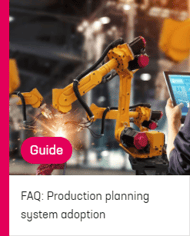 In my work as Director R&D of IPES at Pinja, I get to see a wide range of production planning solutions in customer organisations. The arrangements made in these organisations live over time, as changes take place in their customer base, product variety, resources, machinery, raw materials and market status.
In my work as Director R&D of IPES at Pinja, I get to see a wide range of production planning solutions in customer organisations. The arrangements made in these organisations live over time, as changes take place in their customer base, product variety, resources, machinery, raw materials and market status.
Production planning lives according to need and situation
Regardless of the varying volumes and lines of business, certain elements are shared by all. In a nutshell, production planning refers to the effort of trying to schedule the company’s production operations as optimally as possible while acknowledging demand, the resources available and their capacities, lead time requests and promises as well as the acquisition and availability of raw materials needed.
Since the product varieties of small businesses may be highly limited and simple, Excel sheets make a very logical and usable first step in their production planning. The sheets allow you to write down orders, work phases, materials and planned schedules, and the list can be modified quite easily. What’s more, this solution involves practically no extra expenses.
Then, months and years start to pass by. New products, customers and orders come in. There’s more staff and machinery. Acquisitions become more complex, delivery times and related sanctions grow tighter. The company’s different production factors start to have an increasing number of mutual dependencies. Different departments in the organization start to ask production-related questions that cannot be answered quicky, easily, or at all.
This is the point at which we are usually contacted.
Moving beyond Excel before production boils over
Businesses typically notice that it is high time to replace Excel with production planning software when production factors start to have an unbearable number of mutual dependencies. When a single element changes, ten others should be updated manually. While doing so, the risk of error increases significantly.
Another factor in which the limits of Excel sheets become notoriously visible is key-person dependency. When a long-time production planner suddenly changes jobs or takes a sick leave, the company notices that it has no other employee who can reliably interpret the logic behind the Excel sheet – or, as is often the case, bunch of sheets.
In addition to certain things being difficult in Excel-based production planning, others are outright impossible. For example, setting certain productional or machine-specific limits is practically impossible in Excel – let alone production optimization.
When the complexity of manually processed Excel sheets exceeds a certain level, all energy is put into gathering a single feasible production plan instead of comparing several options and selecting the best one for implementation.
An even more common combination in production planning is ERP+Excel. In this case, basic numeric data resides in the ERP system while Excel sheets are used to illustrate the reality in production and help planners perceive the big picture. Any required data is extracted from the numeric jungle in ERP and transferred to Excel sheets, and the information updated in Excel may be eventually restored to ERP.
Maintaining and updating two data storages back and forth as described is actually very commonplace in processing industry businesses. Also in this combination, challenges often arise from the amount of manual work and key-person dependency involved. The workflow is so highly tailored and fragile for the smallest of errors that further workflow development and replacement arrangements are found to be very difficult.
Why deploy production planning software?
Once our customer company has moved beyond their Excel sheets or Excel+ERP combination, they often wonder in hindsight how they ever managed before. A solution that is based on production planning software enables and facilitates a number of things:
- flexible production schedule modification
- mass timing
- machine- or line-specific limitation setting
- visualization of deviations
- capacity setting and overload prevention
- ’what if’ simulation and selection of optimal alternative
- integration with ERP software and fluent bidirectional data flow
- floor-level progression follow-up
- expansion potential towards shop floor management.
If Excel sheets or the ERP+Excel combination start to feel inadequate for your organization, congratulations! You have exceeded a certain growth level and the time is ripe for the next step. Preferably before production boils over. See our contact information below.
Want to learn more?
Download our free FAQ: Production planning system adoption. After reading it, you will know which aspects to consider while choosing a solution and a partner to best meet your requirements.

Read more
Blog: How to carry out production planning that allows for changes and disturbances?
Blog: Tips for those looking to get a production planning system
iPES by Pinja - Production planning and supply chain management system

Tero Jännes
I work at Pinja as Director R&D of IPES. Our goal in product development is to create and develop easy-to-use visual systems that support our customers’ production planning and shop floor management. I feel inspired by the opportunity to dive into various customer projects and find best-suited solutions. In my free time, I do various sports and coach floorball juniors.
Back to the Pinja Blog
Categories
- Pinja Career (68)
- Business Intelligence (45)
- Production development (44)
- Software development (42)
- Sustainability (37)
- Digital business (30)
- Circular economy and natural resources (27)
- ICT services (24)
- Supply chain management (24)
- Ecommerce (23)
- Maintenance development (22)
- Digital society (19)
- Forest industry ERP (19)
- Industrial digitalization (19)
- ERP (18)
- Artificial intelligence and machine learning (15)
- Industrial innovation (10)
- Health and welfare technology (9)
- Lean (4)
- Integrations (1)
- eudr (1)